Within hours of their December 7, 1941, attack on the American naval base at Pearl Harbor, Hawaii, the Japanese military began its assault on the Philippines, bombing airfields and bases, harbors and shipyards. Manila, the capital of the Philippines, sits on Manila Bay, one of the best deep-water ports in the Pacific Ocean, and it was, for the Japanese, a perfect resupply point for their planned conquest of the southern Pacific. After the initial air attacks, 43,000 men of the Imperial Japanese 14th Army went ashore on December 22 at two points on the main Philippine island of Luzon. Gen. Douglas MacArthur, the supreme commander of all Allied forces in the Pacific, cabled Washington, D.C., that he was ready to repel this main invasion force with 130,000 troops of his own.

Bataan Death March
For whatever reason, MacArthur’s claim that many troops were in error. In fact, his force consisted of tens of thousands of ill-trained and ill-equipped Filipino reservists and some 22,000 American troops who were, in effect, a mixture of “spit-and-polish” garrison soldiers with no combat experience, artillerymen, a small group of plane-less pilots and ground crews, and sailors whose ships happened to be in port when Japanese forces bombed Manila and its naval yards. At the landing beaches, the Japanese soldiers quickly overcame these defenders and pushed them back and back again until MacArthur was forced to execute a planned withdrawal to the jungle redoubt of the Bataan Peninsula. This thumb-like piece of land on the west-central coast of Luzon, across the bay from Manila, measured some 30 miles long and 15 miles wide, with a range of mountains down the middle.
MacArthur had planned badly for the withdrawal and had left tons of rice, ammunition, and other stores behind him. The Battle of Bataan began on January 1, 1942, and almost immediately, the defenders were on half rations. Sick with malaria, dengue fever, and other diseases, living on monkey meat and a few grains of rice, and without air cover or naval support, the Allied force of Filipinos and Americans resisted the Japanese attackers for more than three months even though crippled by starvation rations and epidemics of malaria, dysentery, and various diseases. With no other options, U.S. Gen. Edward King Jr., commander of all U.S. troops in the Philippines, surrendered his approximately 75,000 troops at Bataan as tens of thousands of Filipinos and Americans, the largest American army ever to surrender, on April 9, 1942. This was then the beginning of a shameful chapter in the history of war, the Bataan Death March.
Lt. Gen. Masaharu Homma, a Japanese commander, issued orders to remove any Allied POWs captured on Bataan to the town of Balanga, where they would assemble and receive food. Then the U.S. and Filipino prisoners would move thirty-one miles to San Fernando, where they would board trains and ride to a rail station twenty-five miles away. The prisoners were to finish with a nine-mile walk to Camp O’Donnell. The plan included several stops for food and medical treatment. Most prisoners would go to San Fernando on foot because the Japanese had few vehicles left after the fighting.
The Japanese evacuation plan generally conformed to the terms of the 1929 Geneva Convention for the treatment of POWs. In fact, Homma’s evacuation order specified that Japanese troops were to treat all POWs “in a friendly way.” But the plan was doomed to failure for several reasons:
About 40,000 relatively healthy and well-fed captives were expected. The surrendering army, however, was twice as large, reduced to starvation rations, and so wracked with disease that, according to an Army doctor, they were “patients rather than prisoners.”
The fall of Bataan was expected at the end of April, with the food, medical services, and transportation scheduled accordingly. The surrender happened more than three weeks earlier when little had been prepared.
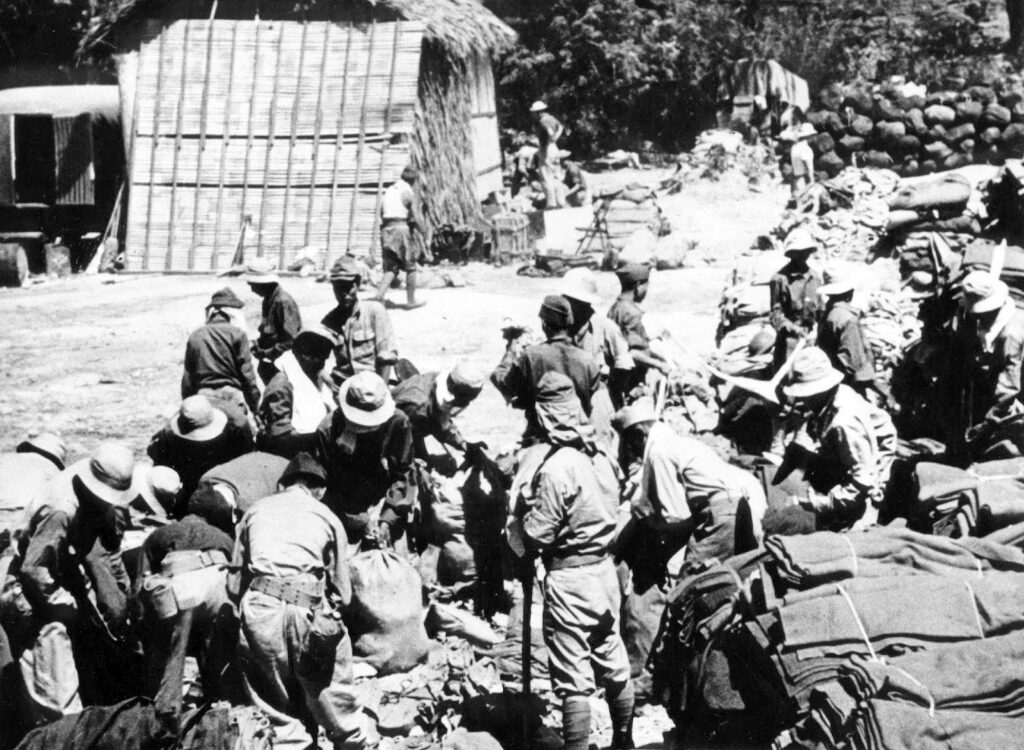
To make matters worse, the Japanese forces, which had been reinforced and now numbered 81,000 men, were chronically short of food and medical supplies for their own needs, let alone for those of their prisoners.
Treatment of the Allied prisoners was inconsistent. Although some prisoners traveled in trucks or cars and suffered little, most were forced to march up to 65 miles on foot and received little food, water, or medical aid. Some groups received more food or time to rest; others received less. Some guards treated their captives reasonably well, while others tortured the POWs or murdered them outright as punishment for surrender, considered dishonorable by the Japanese military code of conduct.
For those who marched to camp, the only constant presence was death. Reports from survivors tell of brutal guards who shot or bayonetted anyone who fell behind. The pace was inhuman under a hot sun, without food or water, difficult even for soldiers in good condition, deadly for malnourished and sick POWs.
One survivor said “They were expected to keep up like everyone else, regardless of their condition. But, some wounded prisoners just couldn’t go on. They were either bayoneted, beat with clubs, rifle butts, or shot. Some soldiers had diarrhea so bad that they couldn’t keep up, and the Japanese shot them.”

Another reported what he had seen on the first day of the march “I saw two things I will never forget. A Filipino man had been beheaded. His body lay on the ground with blood everywhere. His head was a short distance away. Also, there was a dead Filipino woman with her legs spread apart and her dress pulled up over her. She obviously had been raped, and there was a bamboo stake in her private area. These are instances I would like to forget.”
Masaharu Homma Had to Subdue the Fortified Island of Corregidor
In his analysis of the Bataan tragedy and the legal aftermath, “A Trial of Generals“, historian Lawrence Taylor ascribed the guards’ atrocities to three factors, each of which contradicted Homma’s specific directive to treat the POWs humanely. First was the morale of the low-ranking Japanese soldiers. Having suffered themselves during the fighting, having seen many of their comrades die in battle, and having been trained to regard surrender as dishonorable, the Japanese soldiers sought revenge upon their now-helpless foes. The second factor was a shortage of Japanese officers, not enough to properly supervise the prisoner movement. Because a company of infantrymen might be spread out to guard a mile-long file of captives, its commander could not supervise carefully, leaving sadistic guards free to attack captives with impunity. The third factor was the racism of some Japanese junior officers who held the view that the United States was racially inferior to the Japanese.
With the fall of Bataan, Lt. Gen. Masaharu Homma still had to subdue the fortified island of Corregidor, sitting in Manila Bay across from Bataan.
The island bastion of Corregidor, with its network of tunnels and formidable array of defensive armament, along with the fortifications across the entrance to Manila Bay, was the remaining obstacle to the 14th Japanese Imperial Army. The Japanese had to take Corregidor; as long as the island remained in American hands, they would be denied the use of Manila Bay, the finest natural harbor in the Far East.
The Final Assault on Corregidor
On May 5, Japanese forces led by Maj. Gen. Kureo Taniguchi boarded landing craft and barges and headed for the final assault on Corregidor. Shortly before midnight, intense shelling struck the beaches between North Point and Cavalry Point. The initial landing of 790 Japanese soldiers quickly bogged down due to surprisingly fierce resistance from the American and Filipino defenders whose 37 mm artillery exacted a heavy toll on the landing fleet.
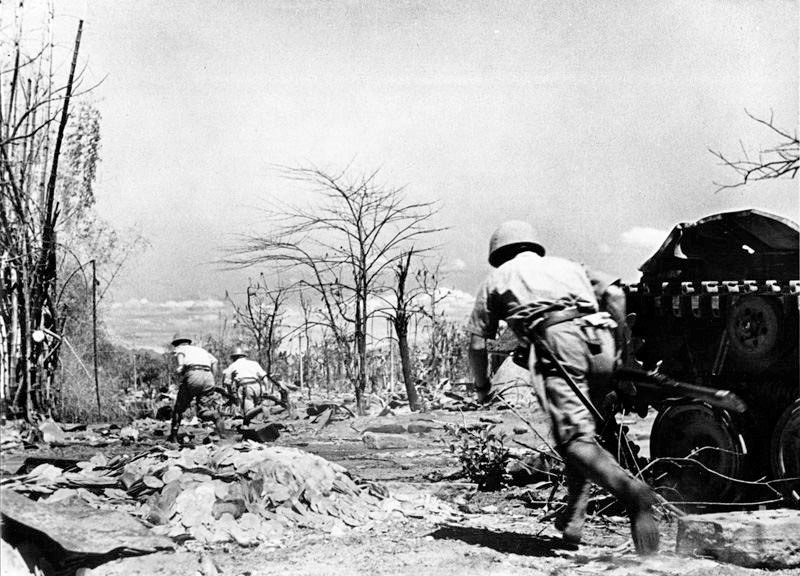
The Japanese Struggled Because of the Strong Sea Currents Between Bataan and Corregidor
The Japanese struggled because of the strong sea currents between Bataan and Corregidor, and from the layers of oil that covered the beaches from ships sunk earlier in the siege, they experienced great difficulty in landing personnel and equipment. However, the overwhelming number of Japanese infantry equipped with 50 mm grenade launchers (“knee mortars”) forced the defenders to pull back from the beach.
The second battalion of 785 Japanese soldiers was not as successful. They encountered the same currents but landed east of North Point, where the defensive positions of the 4th Marines were stronger. Most of the Japanese officers were killed early in the landing; the huddled survivors were hit with hand grenades, machine guns, and rifle fire. Nevertheless, some of the landing craft did reach the location of the first invasion force, and together, they found themselves moving inland where they captured the Denver Battery by 01:30 on May 6.
A counterattack was initiated to eject the Japanese from the Denver Battery. This was the location of the heaviest fighting between the opposing forces, practically face to face. A few reinforcements did make their way to the frontline 4th Marines, but the battle became a duel of obsolete World War I grenades versus the accurate Japanese knee mortars. Without reinforcements, the battle would quickly go against the defenders.
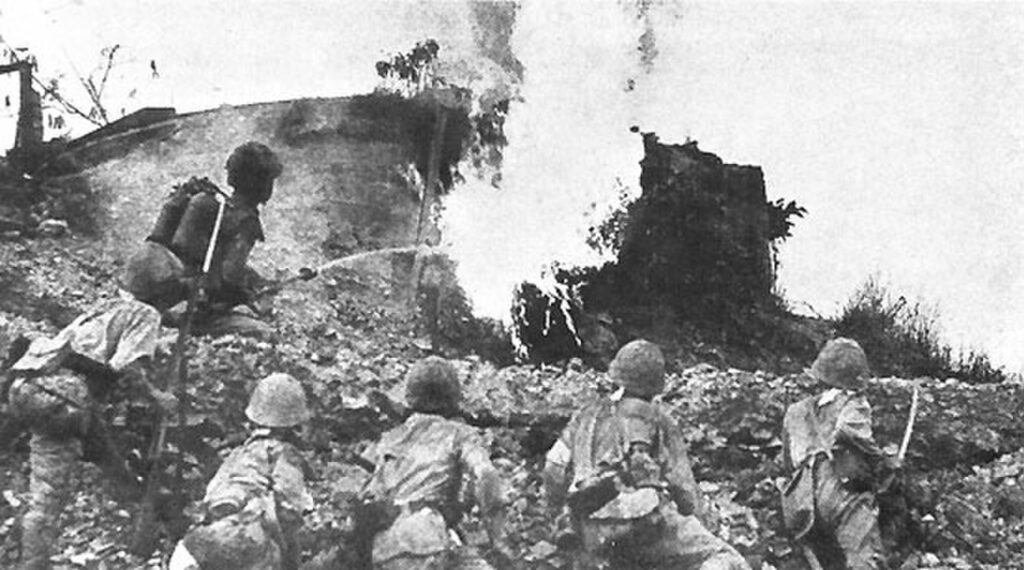
The final blow to the defenders came at about 09:30 when three Japanese tanks landed and went into action. The men around Denver Battery withdrew to the ruins of a concrete trench a few yards away from the entrance to Malinta tunnel, just as Japanese artillery delivered a heavy barrage. Particularly fearful of the dire consequences should the Japanese capture the tunnel, where 1,000 helpless wounded men lay, and realizing that the defenses outside Malinta tunnel could not hold out much longer, Lt. Gen. Jonathan Wainright expected further Japanese landings that night. He also decided to sacrifice one more day of freedom in exchange for several thousand lives.
By 4:30 a.m., Col. Howard had committed his last reserves – some 500 Marines, sailors and soldiers of the 4th Battalion. These men tried to get to the battle as quickly as possible, but several Japanese snipers had slipped behind the front lines to make any movement very costly. An additional 880 Japanese reinforcements arrived at 05:30. The 4th Marines were holding their positions, at the same time losing ground in other areas. The Japanese were facing problems of their own: several ammunition crates never made the landing; as a result, several attacks and counterattacks were fought with bayonets.
In a radio message to President Franklin Roosevelt, Wainwright said, “There is a limit of human endurance, and that point has long been passed.” Howard burned the 4th Regiment’s and national colors to prevent their capture by the enemy. Wainwright finally surrendered the Corregidor garrison at about 1:30 p.m. on May 6, 1942, with two officers sent forward with a white flag to carry his surrender message to the Japanese.
Although their defense was ultimately overwhelmed, the execution of MacArthur’s Bataan plan saved the troops on Luzon from immediate defeat, delayed the Japanese timetable for conquest by four months, and kept large Japanese combat forces tied up in the Philippines until May 1942.
News of the “Bataan Death March” reached the American public in January 1944, when the U.S. War Department released accounts from several survivors who had escaped from prison and reached Allied territory with the aid of Filipino guerrillas. Secretary of State Cordell Hull, congressional leaders, and newspaper editors throughout the United States expressed outrage and shock at the atrocity and vowed revenge for the dead prisoners.
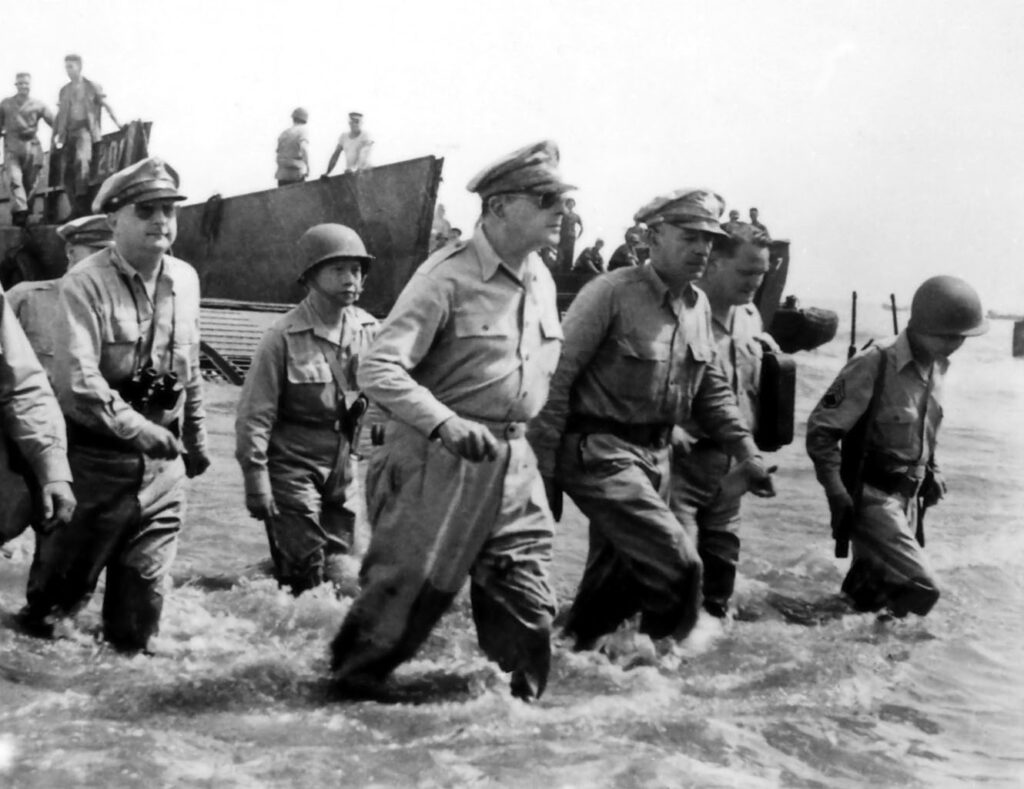
America avenged its defeat in the Philippines with the invasion of the island of Leyte in October 1944. Gen. Douglas MacArthur, who in 1942 had famously promised to return to the Philippines, made good on his word. In February 1945, U.S.-Filipino forces recaptured the Bataan Peninsula, and Manila was liberated in early March.
Shortly after Japan’s official surrender on September 2, 1945, U.S. Army officers arrested Homma. A U.S. military commission arraigned Homma on December 19, 1945, for forty-seven specifications of the charge of violating the laws of war, primarily concerned with mistreatment of POWs on the Death March and in the prison camps afterward, in addition to the bombing of Manila in violation of the open-city declaration.
In his defense, Homma claimed that he was so preoccupied with the plans for the Corregidor assault that he had forgotten about the prisoners’ treatment, believing that his officers were properly handling the matter. He allegedly did not learn of the death toll until after the war. His defense failed, and on April 3, 1946, he was executed by a firing squad, forbidden to wear his military uniform.
By the end of the evacuation in early May 1942, an estimated 5,000 to 10,000 POWs had died. Another 18,000 prisoners died in the first six weeks of imprisonment at Camp O’Donnell. Those who survived remained in Japanese prisons from April 1942 until the end of the war in the Pacific in September 1945, enduring more than three years of torture, beatings, forced labor, illness, and near starvation. Those who were liberated were in terrible condition, their bodies skeletal and ridden by diseases such as beriberi, dysentery, and scurvy.
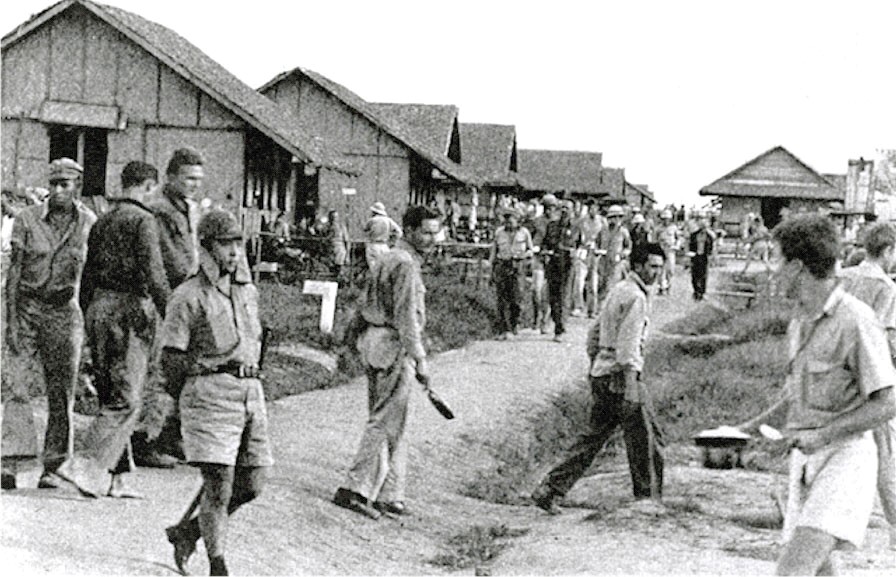
Altogether, 12,935 out of the 34,648 total American POWs died in the hands of the Japanese. Japan captured several thousand additional American prisoners throughout the Pacific; however, the vast majority of prisoners were captured in the Philippine Islands. The overwhelming majority of these prisoners came from the fall of Bataan and later, Corregidor. The fall of Bataan, alone, gave the Japanese in excess of 75,000 troops to deal with; 60,000 of these being Philippine nationals. The POWs in the Philippines experienced a mortality rate of forty percent (40%), with approximately 11,107 deaths out of the 27,465 internees in the Philippines.
The American Defenders of Bataan and Corregidor
In the years that followed, the men who fought in the Philippines formed a veterans’ organization, the American Defenders of Bataan and Corregidor, to press for reparations from Japan and better treatment by the American government of the veterans of these campaigns. In the 1980s, the U.S. officially recognized the suffering and sacrifice of these veterans, awarding them the Bronze Star and eventually classified them as 100 percent disabled for government pensions.
On May 29, 2009, the 73 survivors attending the final ADBC convention in San Antonio, Texas, finally received the apology they deserved, after nearly 64 years of waiting, when Japanese ambassador to the U.S. Ichiro Fujisaki apologized to the assembled attendees for his country “having caused tremendous damage and suffering to many people, including prisoners of war, those who have undergone tragic experiences.”

RIGHT HAND SALUTE For there bravery and sacrifice
As I grew up in Sacramento, California my neighbors were the Comptons. A childless husband and wife. Glen Compton was a survivor of the death march. The nicest, gentlest man you could ever know. Even as a child. I sensed he was suffering in his heart. He literally cried when I told him I was going in the service in 1969. Now I know why. At the time I did not understand why I worried about him so much as he was a huge man of stature. I know now it was his aura.